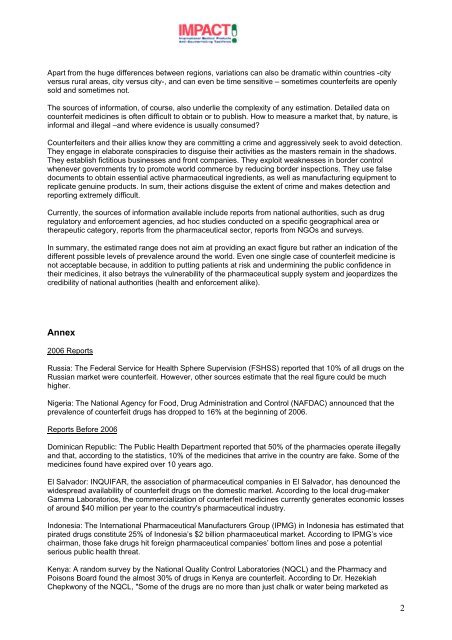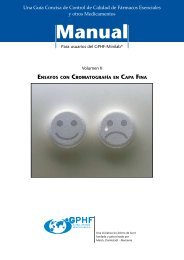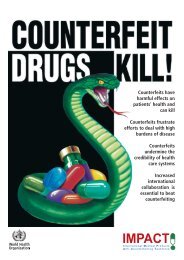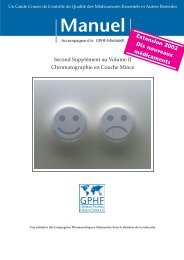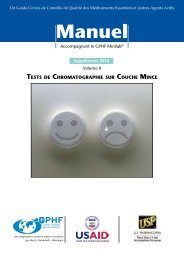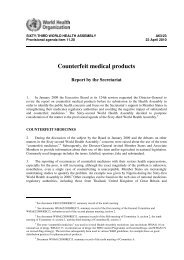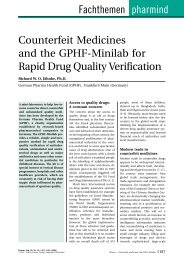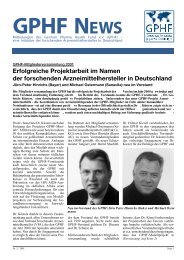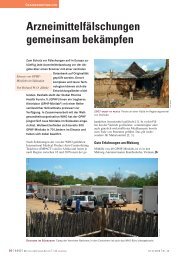Counterfeit Medicines: an update on estimates - World Health ...
Counterfeit Medicines: an update on estimates - World Health ...
Counterfeit Medicines: an update on estimates - World Health ...
You also want an ePaper? Increase the reach of your titles
YUMPU automatically turns print PDFs into web optimized ePapers that Google loves.
Apart from the huge differences between regi<strong>on</strong>s, variati<strong>on</strong>s c<str<strong>on</strong>g>an</str<strong>on</strong>g> also be dramatic within countries -city<br />
versus rural areas, city versus city-, <str<strong>on</strong>g>an</str<strong>on</strong>g>d c<str<strong>on</strong>g>an</str<strong>on</strong>g> even be time sensitive – sometimes counterfeits are openly<br />
sold <str<strong>on</strong>g>an</str<strong>on</strong>g>d sometimes not.<br />
The sources of informati<strong>on</strong>, of course, also underlie the complexity of <str<strong>on</strong>g>an</str<strong>on</strong>g>y estimati<strong>on</strong>. Detailed data <strong>on</strong><br />
counterfeit medicines is often difficult to obtain or to publish. How to measure a market that, by nature, is<br />
informal <str<strong>on</strong>g>an</str<strong>on</strong>g>d illegal –<str<strong>on</strong>g>an</str<strong>on</strong>g>d where evidence is usually c<strong>on</strong>sumed?<br />
<str<strong>on</strong>g>Counterfeit</str<strong>on</strong>g>ers <str<strong>on</strong>g>an</str<strong>on</strong>g>d their allies know they are committing a crime <str<strong>on</strong>g>an</str<strong>on</strong>g>d aggressively seek to avoid detecti<strong>on</strong>.<br />
They engage in elaborate c<strong>on</strong>spiracies to disguise their activities as the masters remain in the shadows.<br />
They establish fictitious businesses <str<strong>on</strong>g>an</str<strong>on</strong>g>d fr<strong>on</strong>t comp<str<strong>on</strong>g>an</str<strong>on</strong>g>ies. They exploit weaknesses in border c<strong>on</strong>trol<br />
whenever governments try to promote world commerce by reducing border inspecti<strong>on</strong>s. They use false<br />
documents to obtain essential active pharmaceutical ingredients, as well as m<str<strong>on</strong>g>an</str<strong>on</strong>g>ufacturing equipment to<br />
replicate genuine products. In sum, their acti<strong>on</strong>s disguise the extent of crime <str<strong>on</strong>g>an</str<strong>on</strong>g>d makes detecti<strong>on</strong> <str<strong>on</strong>g>an</str<strong>on</strong>g>d<br />
reporting extremely difficult.<br />
Currently, the sources of informati<strong>on</strong> available include reports from nati<strong>on</strong>al authorities, such as drug<br />
regulatory <str<strong>on</strong>g>an</str<strong>on</strong>g>d enforcement agencies, ad hoc studies c<strong>on</strong>ducted <strong>on</strong> a specific geographical area or<br />
therapeutic category, reports from the pharmaceutical sector, reports from NGOs <str<strong>on</strong>g>an</str<strong>on</strong>g>d surveys.<br />
In summary, the estimated r<str<strong>on</strong>g>an</str<strong>on</strong>g>ge does not aim at providing <str<strong>on</strong>g>an</str<strong>on</strong>g> exact figure but rather <str<strong>on</strong>g>an</str<strong>on</strong>g> indicati<strong>on</strong> of the<br />
different possible levels of prevalence around the world. Even <strong>on</strong>e single case of counterfeit medicine is<br />
not acceptable because, in additi<strong>on</strong> to putting patients at risk <str<strong>on</strong>g>an</str<strong>on</strong>g>d undermining the public c<strong>on</strong>fidence in<br />
their medicines, it also betrays the vulnerability of the pharmaceutical supply system <str<strong>on</strong>g>an</str<strong>on</strong>g>d jeopardizes the<br />
credibility of nati<strong>on</strong>al authorities (health <str<strong>on</strong>g>an</str<strong>on</strong>g>d enforcement alike).<br />
Annex<br />
2006 Reports<br />
Russia: The Federal Service for <strong>Health</strong> Sphere Supervisi<strong>on</strong> (FSHSS) reported that 10% of all drugs <strong>on</strong> the<br />
Russi<str<strong>on</strong>g>an</str<strong>on</strong>g> market were counterfeit. However, other sources estimate that the real figure could be much<br />
higher.<br />
Nigeria: The Nati<strong>on</strong>al Agency for Food, Drug Administrati<strong>on</strong> <str<strong>on</strong>g>an</str<strong>on</strong>g>d C<strong>on</strong>trol (NAFDAC) <str<strong>on</strong>g>an</str<strong>on</strong>g>nounced that the<br />
prevalence of counterfeit drugs has dropped to 16% at the beginning of 2006.<br />
Reports Before 2006<br />
Dominic<str<strong>on</strong>g>an</str<strong>on</strong>g> Republic: The Public <strong>Health</strong> Department reported that 50% of the pharmacies operate illegally<br />
<str<strong>on</strong>g>an</str<strong>on</strong>g>d that, according to the statistics, 10% of the medicines that arrive in the country are fake. Some of the<br />
medicines found have expired over 10 years ago.<br />
El Salvador: INQUIFAR, the associati<strong>on</strong> of pharmaceutical comp<str<strong>on</strong>g>an</str<strong>on</strong>g>ies in El Salvador, has denounced the<br />
widespread availability of counterfeit drugs <strong>on</strong> the domestic market. According to the local drug-maker<br />
Gamma Laboratorios, the commercializati<strong>on</strong> of counterfeit medicines currently generates ec<strong>on</strong>omic losses<br />
of around $40 milli<strong>on</strong> per year to the country's pharmaceutical industry.<br />
Ind<strong>on</strong>esia: The Internati<strong>on</strong>al Pharmaceutical M<str<strong>on</strong>g>an</str<strong>on</strong>g>ufacturers Group (IPMG) in Ind<strong>on</strong>esia has estimated that<br />
pirated drugs c<strong>on</strong>stitute 25% of Ind<strong>on</strong>esia’s $2 billi<strong>on</strong> pharmaceutical market. According to IPMG’s vice<br />
chairm<str<strong>on</strong>g>an</str<strong>on</strong>g>, those fake drugs hit foreign pharmaceutical comp<str<strong>on</strong>g>an</str<strong>on</strong>g>ies’ bottom lines <str<strong>on</strong>g>an</str<strong>on</strong>g>d pose a potential<br />
serious public health threat.<br />
Kenya: A r<str<strong>on</strong>g>an</str<strong>on</strong>g>dom survey by the Nati<strong>on</strong>al Quality C<strong>on</strong>trol Laboratories (NQCL) <str<strong>on</strong>g>an</str<strong>on</strong>g>d the Pharmacy <str<strong>on</strong>g>an</str<strong>on</strong>g>d<br />
Pois<strong>on</strong>s Board found the almost 30% of drugs in Kenya are counterfeit. According to Dr. Hezekiah<br />
Chepkw<strong>on</strong>y of the NQCL, "Some of the drugs are no more th<str<strong>on</strong>g>an</str<strong>on</strong>g> just chalk or water being marketed as<br />
2


